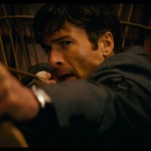In this manner, the movie’s a fitting follow-up to Cosmatos’ first film, 2010’s sci-fi nightmare Beyond The Black Rainbow, which has earned a reputation over the years as a midnight-circuit drug flick, but which doubles as a movie quite specifically about drugs. Sure, it’s got fire-breathing organ riffs and a red-suited golem named “The Sentionaut,” but it is, in practice, a vaporous experience, all elliptical close-ups and breathy, obscured sound design. Like Mandy, it contains a vividly designed drug trip that doubles as a portal to some hellish netherworld. The “black rainbow” of the title is death.
That both movies take place in 1983 is no coincidence. The year’s a gold mine for the sort of practical-effects sci-fi and Heavy Metal high fantasy from which Cosmatos’ films seem to spawn: Deathstalker, Krull, Fire And Ice, Videodrome, Brainstorm, The Keep, not to mention debuts by Metallica and Slayer and enough minor-key synthesizer lines to start a Bandcamp page. But 1983 is also far enough away from the summer of love that it can reflect, darkly, on the fallout of the ’60s, the way its acid-fried true believers turned into deranged, power-mad cultists.
At least superficially, both movies traffic in floods of red lighting, accented by blue and green. Both feature metalheads in the woods, pointed Ronald Reagan clips, and era-specific advertising conveyed in a vaporwave haze. Both obsess over analog A/V equipment, full of tape reels, vinyl cartridges, flickering CRT televisions, and RGB projectors. The structural similarities go much deeper: Each movie spends half its runtime creating an ambient world, with a long, protagonist-free foray into a cult leader’s mind, then a quickening of the violent descent before leaving the protagonist in some mysterious new world. (For Mandy’s Red, it’s some multi-mooned Frazetta dreamscape; for Black Rainbow’s Elena, it’s the ’burbs.) Both end with post-credits shots that layer yet another reality over top, suggesting these were just deeply felt childhood dreams, suffused with a more adult melancholy.
Cosmatos has described the two movies as an inhale and an exhale, a complete thought in two parts. You get the feeling that this cauldron of influences could eventually generate a vast 1983-verse, but he’s tamped expectations for an obligatory third act. The two are fine without it, spiraling around each other like binary stars, sharing ideas and sucking in other genres through some dark energy. Mandy turns into an action movie as strangely as Black Rainbow becomes a horror film, as if all of their creator’s influences were some primordial goo, mutable but possessing its own will. Cosmatos is unabashed about this sense of nostalgia, telling BirthMoviesDeath, “That’s what 1983 represents: the realm of imagination where, when I was a kid, I would look at VHS tapes of horror movies and pulp novels. I’d read the backs of them and look at their cover art, imagining what they actually looked like based on those paintings and descriptions, because I wasn’t allowed to rent them.” He’s also said that Black Rainbow was a response to the death of his father, the director George Cosmatos, and that the film was financed through Tombstone residuals. The elder Cosmatos gave his son his first filmmaking gig in that movie’s second unit, and it’s easy to see this “inhale” and “exhale” as a way to grieve through genre pictures while still celebrating their lurid spectacle—a love and a language shared between generations. (Panos’ favorite film of his father’s, for what it’s worth, is Of Unknown Origin, from—you guessed it—1983.)
There are plenty of pastiches that mash up and repackage the touch points of the ’80s, from Rob Zombie to the Duffer brothers, but few with the purposefulness of Cosmatos’ 1983 films. They have a shape all their own. There’s a childlike sense of joy to the way they imagine what was in those horror movies and pulp novels, and a determination to hide the periphery, any backstory that might puncture the dream. This works better in Black Rainbow than in Mandy, which, as a revenge movie, demands certain pieces of exposition that Cosmatos refuses to provide, instead trusting Cage’s primal howl to suffice. Eventually, you give into his will—the pacing, the shrouded edges of the world, all that fucking red—the way you do any sufficiently hallucinatory drug, letting it take the wheel until the effects wear off. The result may be fun, or funny, or terrifying, or melancholy, or, more likely, some mixture of all of the above, often simultaneously. Both films are bound for the midnight circuit, at least in places where such a thing exists, but, like 2001: A Space Odyssey, they feel larger than that token delineation, a reminder that we come to drugs and films, ultimately, for very similar reasons. For Cosmatos—and his protagonists—“escape” is something sacred.








































